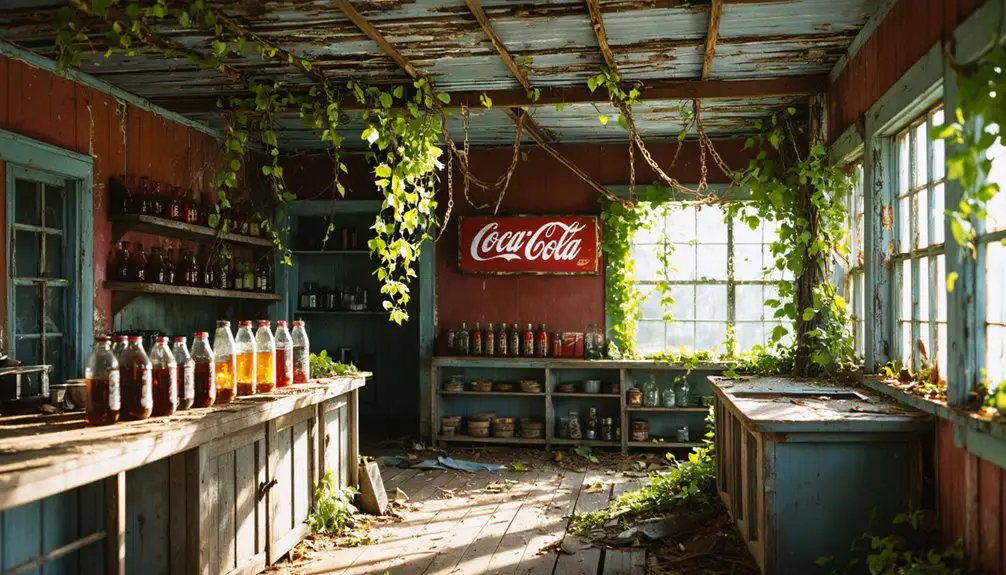You’ll find Linden’s ghost town roots in Polk County, where the Morgan family established a vibrant farming settlement in 1842. The community thrived on agricultural traditions, with pioneers rising before dawn to work the land using basic tools and bartering systems. After the post office closed in 1955, Linden transformed into a ghost town, though its heritage lives on through preserved landmarks and annual gatherings. The untold stories of this Welsh-American settlement await in its quiet forests.
Key Takeaways
- Linden transformed into a ghost town following the closure of its post office in 1955, marking the end of its thriving agricultural era.
- Founded in 1842 by the Morgan family, Linden was initially a successful farming settlement in Polk County before its eventual decline.
- The community preserves its heritage through volunteer-maintained cemeteries, restored landmarks, and guided tours of remaining historical sites.
- Located at 28.1°N and 81.7°W, Linden’s accessibility diminished as local roads wound through forests and former rail corridors became scattered paths.
- Annual community events and reunions feature traditional farming demonstrations and historical exhibits to maintain the ghost town’s cultural legacy.
Pioneer Beginnings: The Morgan Family Legacy
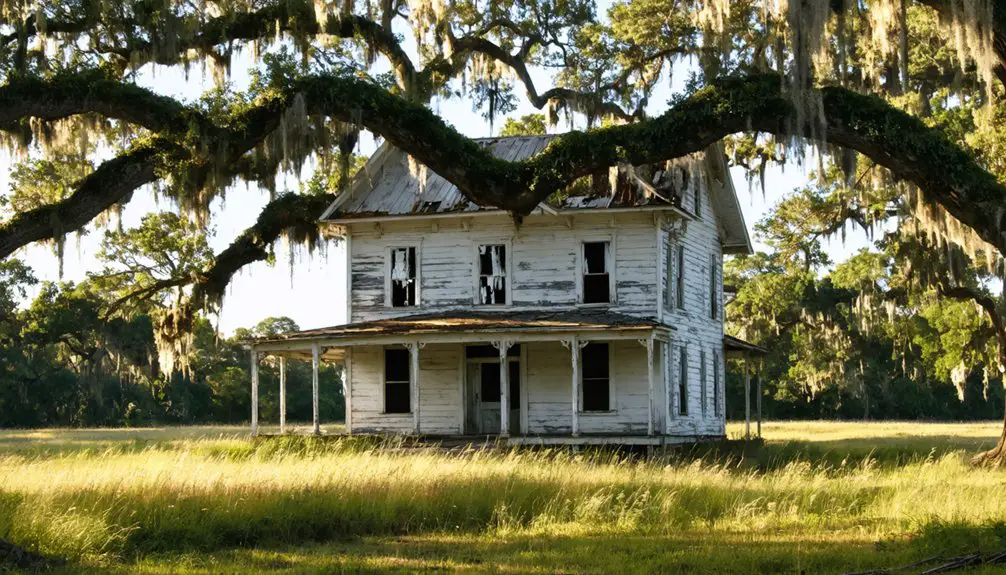
While the Second Seminole War drew to a close in 1842, the Morgan family established what would become the ghost town of Linden, Florida.
Their pioneering spirit woven into every acre of this settlement, as they owned all the surrounding land for nearly twenty years. Their vision shaped Linden’s earliest identity as an agricultural community, with farming at its heart. Much like the heart-shaped leaves of its namesake tree, the town took on a distinctive character of its own.
When John Morgan decided to sell portions of the family’s holdings, you could say he planted the seeds of change.
Yet the Morgan family’s influence remained strong through generations, as evidenced by their descendants who still call this area home.
Their Welsh ancestry and early American settler roots created a legacy that transformed wild Florida frontier into a close-knit farming community.
The community’s growth led to the establishment of a post office in 1888.
Life in Early Linden Settlement
You’d find pioneer families like the Morgans rising before dawn to tend their small farms, employing basic tools like hoes, plows, and draft animals to cultivate the Florida soil.
Their daily routines revolved around seasonal agricultural cycles – planting in spring, maintaining crops through summer, harvesting in fall, and preserving food for winter. Much like the early Native American tribes, their survival depended heavily on understanding local water sources, particularly the natural sinkholes and limestone basins in the area.
The settlers would’ve exchanged surplus crops, livestock, and handmade goods with neighboring families, creating an informal economy based on mutual support and bartering rather than cash transactions. Like the Spanish colonists who established Fort Mose, these early settlers formed tight-knit communities for mutual protection and support.
Pioneer Family Daily Routines
As families settled in early Linden, their daily routines centered around essential tasks that sustained life in the Florida wilderness.
You’d find pioneer chores beginning at dawn, with family members gathering firewood and heating water in cast iron pots for cooking and washing. Your days would revolve around the rhythms of farming, tending livestock, and preserving food through smoking, salting, and drying techniques. Families often practiced traditional canning methods, a skill still taught to preserve heritage at historical sites today. Similar to the rural living history demonstrated at Panhandle Pioneer Settlement, these activities gave structure to pioneer life.
Family roles were clearly defined, with children fetching water and helping in gardens while parents tackled more demanding tasks.
You’d spend evenings mending clothes by hand or gathering around the fire for storytelling sessions. When you weren’t working the land, you’d hunt in nearby woods or fish in local waterways to supplement your family’s food supply.
Agricultural Methods and Tools
The Morgan family brought their agricultural expertise to Linden in 1842, establishing farming techniques that would shape the settlement for decades.
You’d find their methods focused on sustainable practices like crop rotation and livestock management, adapting to Florida’s warm climate with minimal irrigation.
Their agricultural approach centered around these core elements:
- Hand-powered tools dominated farm work, from hoes and plows to sickles for harvesting.
- Animal labor proved essential, with livestock serving dual purposes of field preparation and food production.
- Family-centered farming operations emphasized cooperation, sharing labor during peak seasons.
- Local ecosystem resources determined tool creation and farming methods, ensuring self-sufficiency.
Daily farm life meant rising with the sun to tend crops and animals, using simple but effective techniques passed down through generations.
Like Pine Level’s early settlers, they frequented local sawmills to obtain lumber for building farm structures and equipment.
The community’s agricultural lifestyle continued until serial killer murders in the early 1900s forced many farming families to abandon their land.
Community Trading and Bartering
While cash was scarce in early Linden, a vibrant trading economy flourished through bartering essential goods and services. You’d have witnessed the barter dynamics unfold at social gatherings like the annual Cemetery Picnic, where families exchanged surplus crops, handmade tools, and textiles for items they needed.
Trust-based exchanges strengthened the bonds between pioneer families, particularly the Morgans and their kin networks. Similar to the Spanish settlement of Fort Mose, Florida’s early communities relied heavily on cooperative exchange systems.
The community’s resilience shone through their resourceful trading practices. You’d find blacksmiths swapping services for foodstuffs, while carpenters traded furniture for domestic help. Similar to early territorial settlers, many Linden residents came from Virginia and the Carolinas seeking new opportunities.
These informal exchanges, often conducted at homes rather than established marketplaces, helped settlers weather economic hardships and isolation. The 1888 post office establishment, while improving communication, didn’t diminish Linden’s reliance on this personal trading system.
The Rise and Fall of a Farming Community
Founded amid the waning days of the Second Seminole War in 1842, Linden emerged as a modest farming settlement under the stewardship of the Morgan family, who maintained exclusive ownership of the surrounding lands for over two decades.
The community’s resilience shone through its agricultural heritage, with families working the fertile soil and building a close-knit society centered around farming traditions.
Despite their determination, Linden faced mounting economic challenges:
- The town’s isolation from major railroad routes limited trade opportunities
- Mechanization of agriculture reduced the need for farm labor
- Young residents sought opportunities in larger urban centers
- The closure of the post office in 1955 marked a turning point in decline
The once-thriving farming community gradually transformed into a ghost town, though its legacy lives on through the annual Linden Cemetery Picnic and enduring Morgan family presence.
Preserving Heritage Through Annual Gatherings
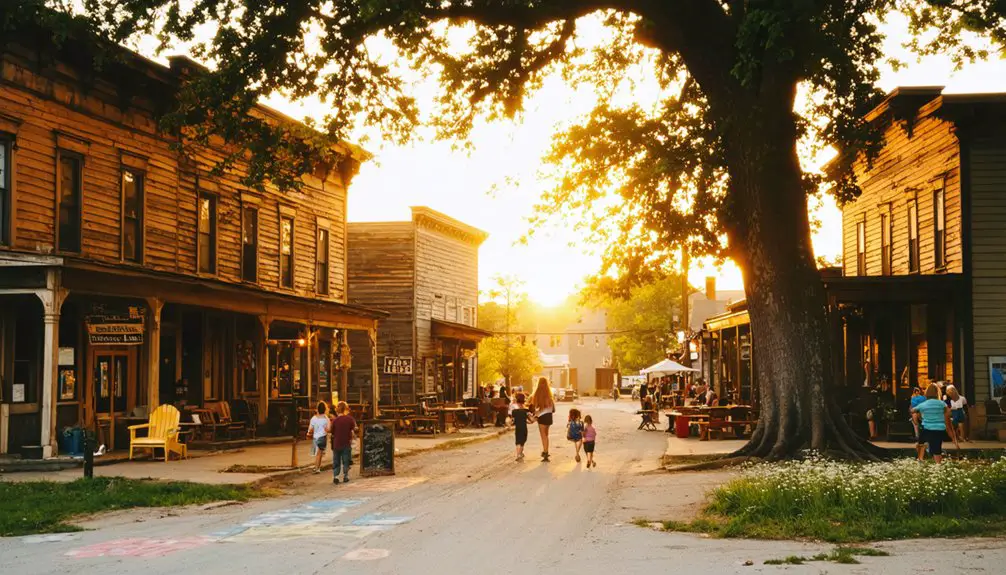
Through dedicated annual gatherings, Linden’s heritage endures despite its ghost town status. You’ll find these events serve as living museums, where heritage storytelling brings the past to life through shared photographs, artifacts, and tales from descendants of original settlers.
Community collaboration drives preservation efforts, as volunteers work together to maintain cemeteries, restore landmarks, and document historical items.
You can experience traditional crafts, farming demonstrations, and guided tours of remaining sites during these reunions. Local students engage with history firsthand, ensuring intergenerational knowledge transfer.
The gatherings also attract tourism, positioning Linden on Florida’s historical map while generating support for preservation projects. Through these annual events, you’re not just witnessing history – you’re participating in keeping Linden’s cultural legacy alive for future generations.
Notable Landmarks and Historical Sites
Despite its ghostly stillness today, Linden’s landscape remains dotted with compelling historical landmarks that tell the story of its thriving past.
You’ll discover tangible connections to the town’s vibrant logging heritage through concrete foundations and bolt patterns where bustling sawmills once operated.
- The preserved railroad grades and float ponds showcase the innovative transport systems that once moved mighty cypress logs through the area.
- Historic cemeteries, including Linden Cemetery and Oriole Cemetery, stand as solemn guardians of the town’s earliest settlers.
- Original homestead sites reveal the daily lives of founding families through artifacts scattered across the forest floor.
- Old roadbeds and infrastructure remnants trace the paths where commerce and community once flourished within the Withlacoochee State Forest.
Ghost Town Geography and Regional Context
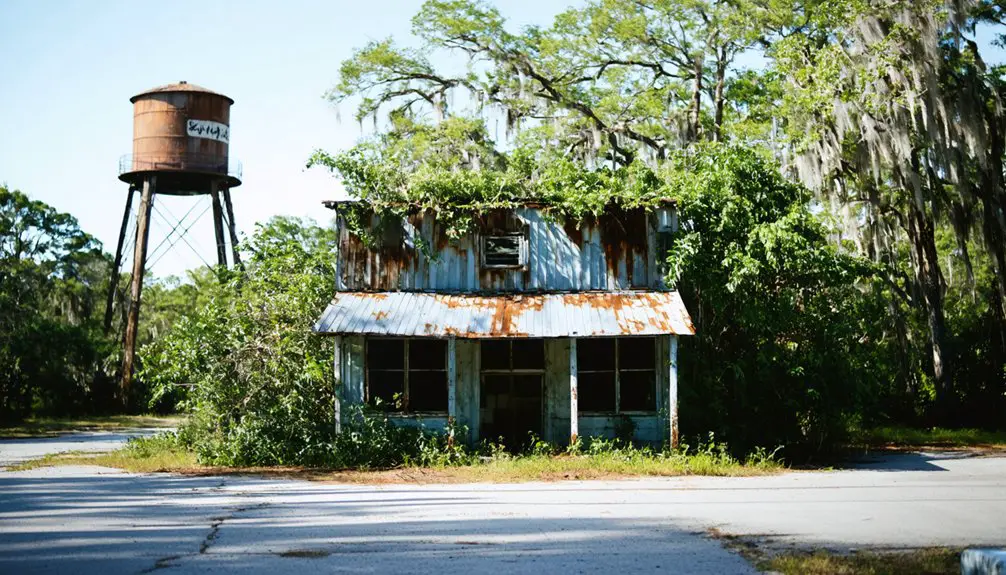
You’ll find Linden nestled in Polk County’s interior at roughly 28.1°N and 81.7°W, where old tram lines and discontinued railways once connected this timber town to neighboring ghost settlements.
The site’s accessibility has diminished since its heyday, with former rail corridors now replaced by scattered local roads winding through pine forests and agricultural plots.
Linden’s position within Central Florida’s network of abandoned timber communities reflects a broader pattern of resource-dependent settlements that faded as the region shifted from logging to modern farming and development.
Location and Access Points
Nestled in the heart of Sumter County, Florida, the ghost town of Linden rests at coordinates 28°33.7’N latitude and 82°2.0’W longitude, surrounded by a tapestry of pine flatwoods and hardwood hammocks.
You’ll find what remains of this forgotten settlement accessible primarily through local secondary roads, where ghost town infrastructure has largely surrendered to nature’s reclamation.
- Access requires maneuvering partially maintained or abandoned roadways, some of which transform into dirt tracks during your approach.
- Weather conditions greatly impact accessibility, with seasonal rains often creating challenging terrain.
- Most reliable entry points connect through rural backroads, though they’re not always clearly marked.
- Nearby springs and cypress swamps create natural barriers, requiring careful route planning to reach the site’s core.
Surrounding Ghost Town Network
While Linden stands as a poignant reminder of Florida’s boom-and-bust settlement patterns, it’s part of a broader network of ghost towns that once dotted Sumter County‘s landscape.
You’ll find Warnell, an old lumber company town that faded after 1898, and Eldorado, which thrived through railroad and steamboat connections until 1910. The historic Linden Cemetery and its century-old picnic tradition serve as an anchor point for ghost town exploration in the region.
These settlements tell a complex story of economic shifts and transportation networks.
While some communities like San Antonio have preserved their historic character through vernacular architecture, others have vanished almost completely.
Today, you can trace these forgotten places through Marion, Lake, Hernando, and Sumter counties, each offering glimpses into Central Florida’s dynamic past.
Agricultural Land Development Pattern
Three distinct agricultural patterns shaped Linden’s development before its decline into a ghost town.
You’ll find evidence of early Native American cultivation merged with European settler farming traditions, followed by the transformative impact of corporate agriculture and infrastructure development.
- The shift from diverse native forests to cleared farmland reflected the region’s move toward crop diversification, including cotton, tobacco, and sugarcane.
- Land reclamation efforts through drainage systems converted wetlands into productive agricultural areas.
- The 1920s land boom led to widespread subdivision of farming parcels, creating a patchwork of small holdings.
- Railroad expansion enabled larger-scale farming operations, though repeated freezes disrupted agricultural stability.
These patterns ultimately contributed to the area’s economic vulnerability and eventual abandonment, leaving behind traces of ambitious agricultural dreams.
Impact on Florida’s Settlement History
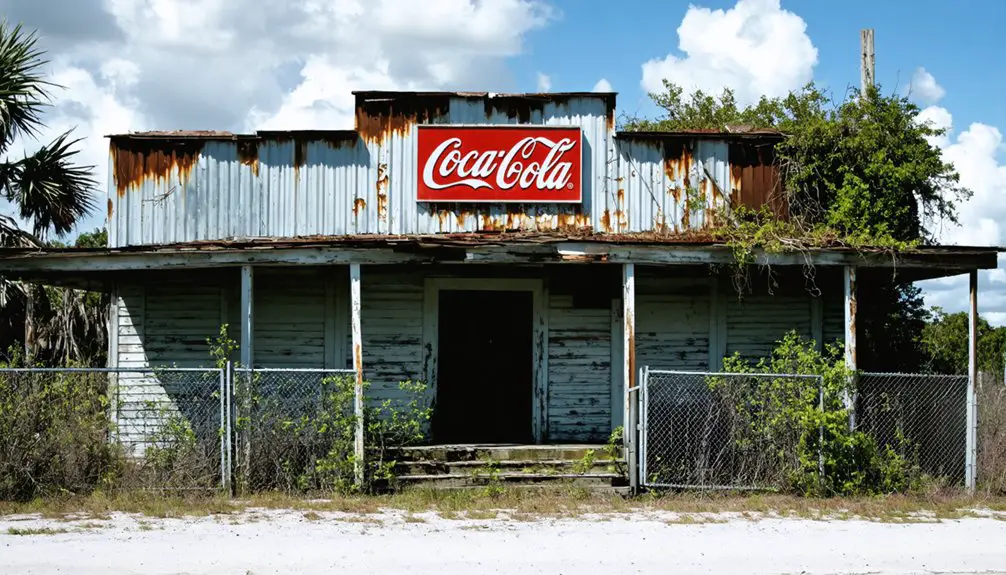
During Florida’s pioneering era of the late 19th century, Linden’s rise and fall exemplified the precarious nature of early settlement patterns throughout the state.
You’ll find that settlement migration was common as residents adapted to harsh economic realities, moving from failing communities to more promising locations.
The town’s story mirrors countless others across Florida, where economic shifts forced dramatic changes in population distribution.
Like many of its contemporaries, Linden emerged during a period of rapid development, only to face challenges that would ultimately lead to its abandonment.
Today, you can trace how these ghost towns shaped Florida’s modern landscape, as people gravitated away from resource-dependent communities toward emerging urban centers.
Linden’s legacy lives on as a reflection of the fluid, adaptable spirit of Florida’s early settlers.
Frequently Asked Questions
What Happened to the Original Buildings and Homes of Linden’s Settlers?
You won’t find any abandoned structures standing today – they’ve all vanished through decay and neglect. Unlike other ghost towns with historical preservation efforts, only Linden’s cemetery remains as evidence to settler life.
Are There Any Remaining Morgan Family Descendants Living in Florida Today?
You’ll find numerous Morgan descendants in Florida today, most significantly John Morgan’s family in Orlando. While their family history connects to early American settlers, direct Morgan lineage from Linden’s original settlers remains unconfirmed.
What Crops Were Primarily Grown by Linden’s Farming Community?
You’d find tomatoes, corn, and sweet potatoes dominated Linden’s farms, alongside citrus farming ventures. Farmers rotated crops with peas for soil health, while cotton production wasn’t particularly significant in the area.
How Many People Typically Attend the Modern Linden Cemetery Picnic?
You’ll find around 50-200 people gathering to honor cemetery traditions through picnic activities each June, with attendance varying based on weather and how many descendants make the journey home.
Was There Ever a School or General Store in Linden?
You’d think tracking a simple store or school would be easy, but historical records don’t confirm either one. While community memories suggest basic amenities existed, there’s no documented proof of their presence.
References
- https://www.fortogden.com/ghost-town-pine-level-fl/
- https://beyond.nvexpeditions.com/florida/linden.php
- https://www.ocalastyle.com/ghost-towns-of-lake-sumter/
- https://jimmyboi2.wordpress.com/2010/11/03/wandering-small-town-florida/
- https://en.wikipedia.org/wiki/List_of_ghost_towns_in_Florida
- https://kids.kiddle.co/Linden
- https://archive.org/download/historyoffamilyo00morg/historyoffamilyo00morg.pdf
- https://freepages.genealogy.rootsweb.com/~ncmorgan/
- https://ancestors.familysearch.org/en/KZ63-XTT/mary-catherine-morgan-1868-1942
- https://en.wikipedia.org/wiki/History_of_Florida
